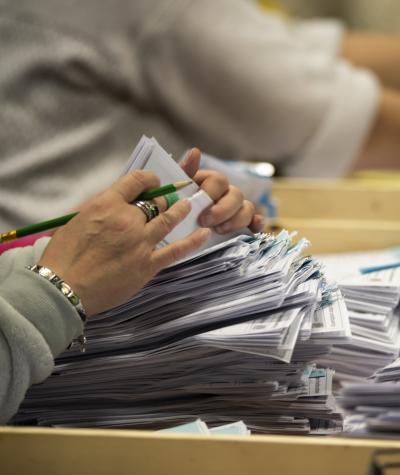American elections have many built-in processes for verification and review before, during and after a vote is cast. This is especially true when voting by mail.
After a voter fills out and returns a mail ballot, it goes through a host of steps prior to being counted and election results being released to the public. These steps are known as ballot processing and can include opening envelopes and removing ballots, verifying signatures on envelopes and preparing ballots for counting or scanning.
Because so much must be done after a ballot has been received but before it can be counted, many states allow election officials to start with one or more of these steps prior to election day.
This is known as pre-processing (sometimes referred to as “pre-canvassing”) and allows election officials to complete most or all of these administrative tasks, short of counting the ballots, before polls close on election day.
Language around processing and counting ballots can vary from state to state and leave voters confused as to what is happening to their ballot.
Crucially, ballots that are processed and, in some states, scanned by tabulators (the secure machines used to efficiently count ballots) before polls close on election day, are not totaled. This helps to ensure that results are not available and therefore cannot be released before polls close on election day.
States with pre-processing laws have strict procedures around publication of election results, as well as criminal penalties for violating these procedures, to ensure that any information that could impact voter turnout (such as vote totals) is not released early.
With these important guardrails in place, pre-processing ensures an election runs as efficiently and securely as possible.
First, pre-processing is beneficial to election officials, who have several competing roles and are stretched thin on election day and in the days immediately following. Pre-processing should go hand in hand with policies that create permanent mail ballot lists or states that proactively mail all eligible voters a ballot to lessen any resulting strain on the system.
Allowing election officials to process mail ballots before election day provides a much-needed head start and ensures the process does not become delayed by ballots turned in during the final days of voting (or on election day itself in some states).
Additionally, pre-processing ballots allows states to notify voters earlier of any deficiencies in their ballot that they need to correct (a process known as “curing”), such as a signature that does not match the voter signature on file.
While many states have a window following election day for voters to cure their ballots, the number of days vary, and allowing election officials and voters more time grants them greater flexibility to solve any issues and ensure that every vote is counted.
Finally, when ballots are not pre-processed, election officials frequently require more time following the close of polls to deliver results. As we have seen in past elections, this can provide an opportunity for misinformation and disinformation to spread by those looking to cast doubt on the process.
While some states do not allow any ballot pre-processing, those that have laws on the books vary considerably in how much time election officials are granted to pre-process ballots and what processes they can complete.
The most expansive pre-processing policies allow election officials to start processing ballots as soon as they are received. Arizona, Colorado, Oregon and Washington are just a few states that allow this. More restrictive pre-processing policies allow election officials to begin processing the morning of election day, such as in Mississippi, Pennsylvania and South Dakota.
Additionally, some states only allow election officials to check signatures on ballot envelopes, while others allow ballot envelopes to be checked and opened, and ballots removed and prepared for counting or scanning.
While the best pre-processing policies give election officials as much time and flexibility as possible to complete the tasks required to scan and count ballots, even a single day of pre-processing can make a difference and provide meaningful benefits to both election officials and voters.
Pre-processing is a key policy that helps both the everyday Americans serving as election officials and the voters who — because of pre-processing — have more time to remedy any issues with their ballots and ensure that their voices are heard.

